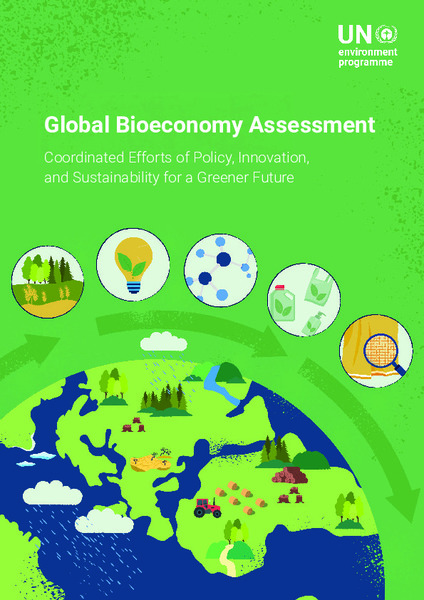| dc.contributor | Ecosystems Division | en_US |
| dc.contributor.author | United Nations Environment Programme | en_US |
| dc.contributor.other | Wang, Yutao | en_US |
| dc.contributor.other | Sun, Mingxing | en_US |
| dc.contributor.other | Zhang, Linxiu | en_US |
| dc.date.accessioned | 2024-04-11T09:59:26Z | |
| dc.date.available | 2024-04-11T09:59:26Z | |
| dc.date.issued | 2024-04 | |
| dc.identifier.isbn | 978-92-807-4142-1 | en_US |
| dc.identifier.other | DEP/2632/NA | en_US |
| dc.identifier.uri | https://wedocs.unep.org/20.500.11822/45332 | |
| dc.description | The bioeconomy, also known as the bio-based
economy, refers to the economic activity involving
the use of biotechnology and biomass in producing
goods, services or energy. It aims to reduce the
dependence on fossil fuels in the energy and
industrial sectors. Bioeconomy has been widely
accepted by different countries and regions as a
critical strategy for coping with fossil fuel shortage
and climate change, among other environmental
problems. Bioeconomy mainly utilizes biomass
resources to generate bio-based products. In terms
of biomass resources, they can be divided into three
generations. The first-generation biomass resources,
primarily edible biomass materials, present an
issue of “competing with people for food/land.” The
second-generation biomass resources are derived
from non-edible sources, mainly lignocellulosic
materials, which are accompanied by immature
processes for their efficient conversion into valuable
biofuels and other high-value bioproducts. Thirdgeneration
biomass resources represent an emerging
frontier in the world of sustainable bioenergy and
bioproducts, primarily consisting of algae or rapidly
synthesized biomass achieved through advanced cell
engineering techniques. This report focuses on
bioenergy, bio-based chemicals, bio-based plastics
and bio-based macromolecular materials (textiles
and paper) in technical conversion, highlighting the resources, dominating technical routes, challenges
and prospects. | en_US |
| dc.format | pdf | en_US |
| dc.language | English | en_US |
| dc.publisher | United Nations Environment Programme | en_US |
| dc.rights | Public | en_US |
| dc.subject | biomass | en_US |
| dc.subject | land use | en_US |
| dc.subject | biodiversity | en_US |
| dc.subject | climate change mitigation | en_US |
| dc.subject | energy | en_US |
| dc.subject | textile | en_US |
| dc.subject | textile industry | en_US |
| dc.title | Global Bioeconomy Assessment: Coordinated Efforts of Policy, Innovation, and Sustainability for a Greener Future | en_US |
| dc.type | Publications | en_US |
| dc.type | Reports, Books and Booklets | en_US |
| wd.topics | Finance and Economic Transformations | en_US |
| wd.identifier.doi | https://doi.org/10.59117/20.500.11822/45332 | |


